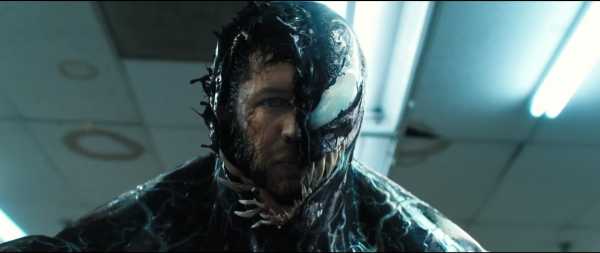
Venom has two credits scenes: The first teases a sequel and a recognizable villain. The second has nothing to do with Venom, but rather serves as a tease for the upcoming animated feature film Spider-Man: Into the Spider-Verse.
Over the past several years, mid- and post-credits scenes have become a superhero movie tradition. Though Marvel is most famous for them, they’re something that fans look forward to every time a major movie studio — Marvel, Fox, Sony, Warner Bros. — puts out a superhero-centric release. Sometimes, they contain huge reveals that hint at future films (see: Thanos intercepting Thor’s Asgardian spaceship at the end of Thor: Ragnarok, which nodded toward Avengers: Infinity War).
Other times, they serve as little winks from studios to their biggest fans. Sony, the studio that brought us Venom, did this in one of the credits scenes for Spider-Man: Homecoming (which it co-produced with Marvel). In it, Captain America mused on the virtue of patience, implying that post-credits scenes won’t always feature big reveals.
They’re often fun. They can be exciting. And if we’re lucky, they give us something to chew on until the studio’s next big release.
Here’s what happens in Venom’s two credits scenes, and what the scenes tell us about Sony’s plan for the titular Symbiote’s future adventures.

1) The mid-credits scene sets up a sequel featuring Woody Harrelson as Cletus Kasady, a.k.a. Carnage
Venom’s first credits scene, which airs in the middle of the credits, functions as both a mini-epilogue for the film and a tease for a future sequel. Brock is on a motorcycle trip to San Quentin Prison to do an interview with a mystery convict, and Venom is inside his head. After an ominous warning from one of the prison guards, the mystery convict is revealed — and it’s none other than Cletus Kasady, played by Woody Harrelson. In Marvel’s comic books, Kasady is the villain known as Carnage, and to drive that point home, Harrelson looks into the camera and says, “There’s going to be carnage” as the scene fades to black.
This scene is — Venom’s box-office performance willing — a setup for a sequel, with a direct reference to who that sequel’s villain would be.
Related
Venom, Spider-Man’s symbiote supervillain, explained
Like Venom, Carnage is a Symbiote — the race of aliens that bond with their hosts and grant them superpowers. In the comics, the Carnage Symbiote is Venom’s offspring and bonds with Brock’s cellmate, Kasady (the comic books and movie diverge when it comes to Brock’s origin story; Brock isn’t a criminal in the movie).
Kasady is a sadistic, murderous psychopath, and his bond with Carnage creates a character that’s much more deadly, vicious, deranged, and violent than Venom. As such, he’s often been used by writers and artists to reflect on Venom’s (relative) humanity.
With that said, Venom only loosely follows its source material, and Kasady’s transformation into Carnage might not go by the book. And depending on how well Venom does at the box office, a sequel isn’t necessarily a given. But if one does happen, Carnage is ready to go.
2) The second credits scene is an extended sequence from Spider-Man: Into the Spider-Verse
Appearing near the end of the credits, Venom’s second credits scene begins with a comic book–style title card that reads, “Meanwhile, in another universe …”
The scene is animated and centers on a young boy whom comic fans will quickly recognize as Miles Morales, a Spider-Man who originated in an alternate Marvel universe. Morales was ultimately absorbed into the main universe’s canon, thanks to dimensions collapsing and other comics hijinks. The credits scene is an extended look at Sony’s upcoming film Spider-Man: Into the Spider-Verse, which arrives in theaters on December 14, 2018.
We see Morales zipping around New York City, getting chased by a villain, accidentally knocking an older Peter Parker unconscious, and then getting chased again. The scene showcases the bright tone and slapstick humor of the much-anticipated animated feature, and though it has absolutely nothing to do with Venom, it’s totally fun and worth sitting through the credits to see.
Sourse: vox.com






